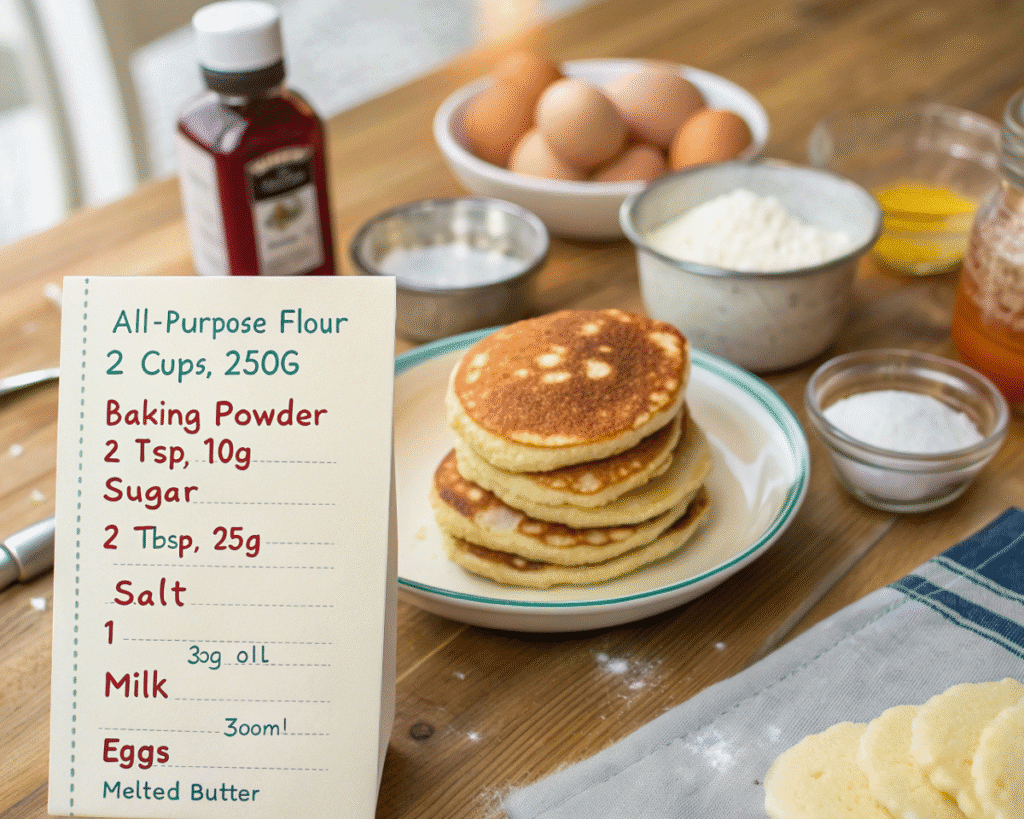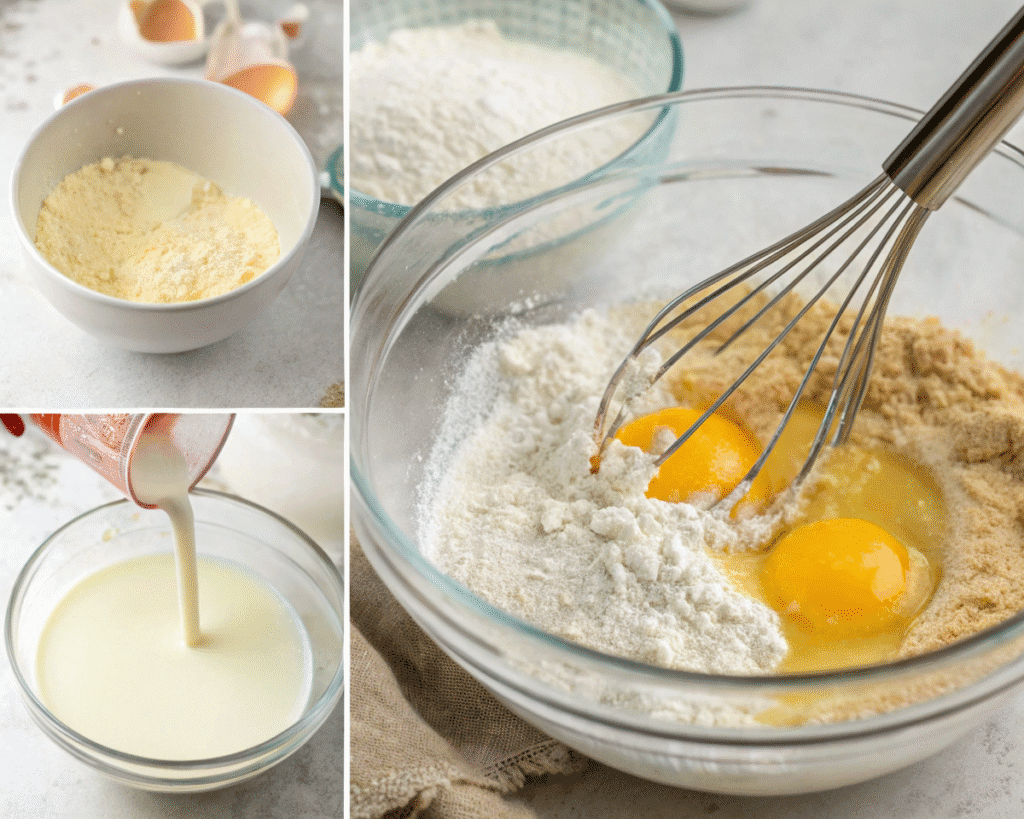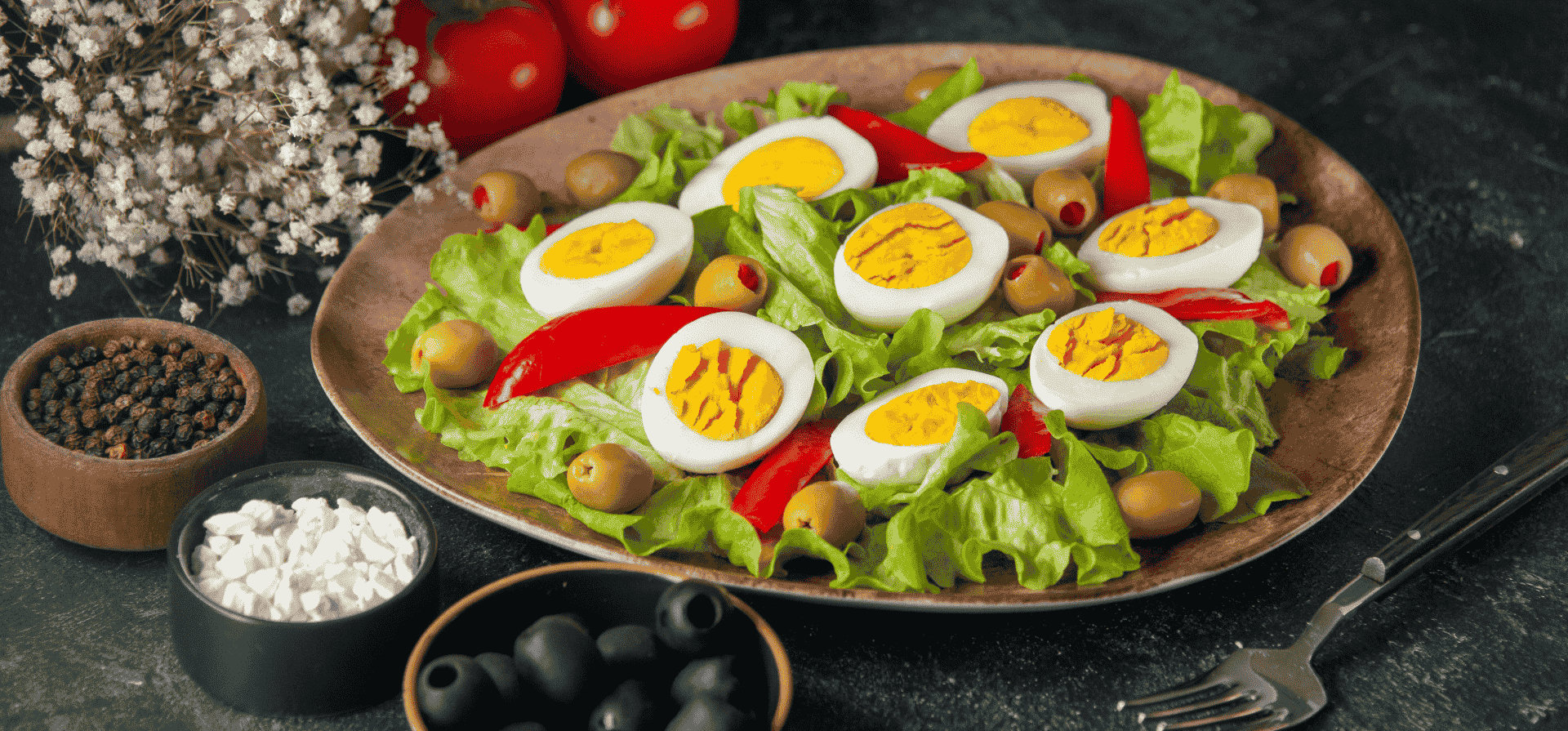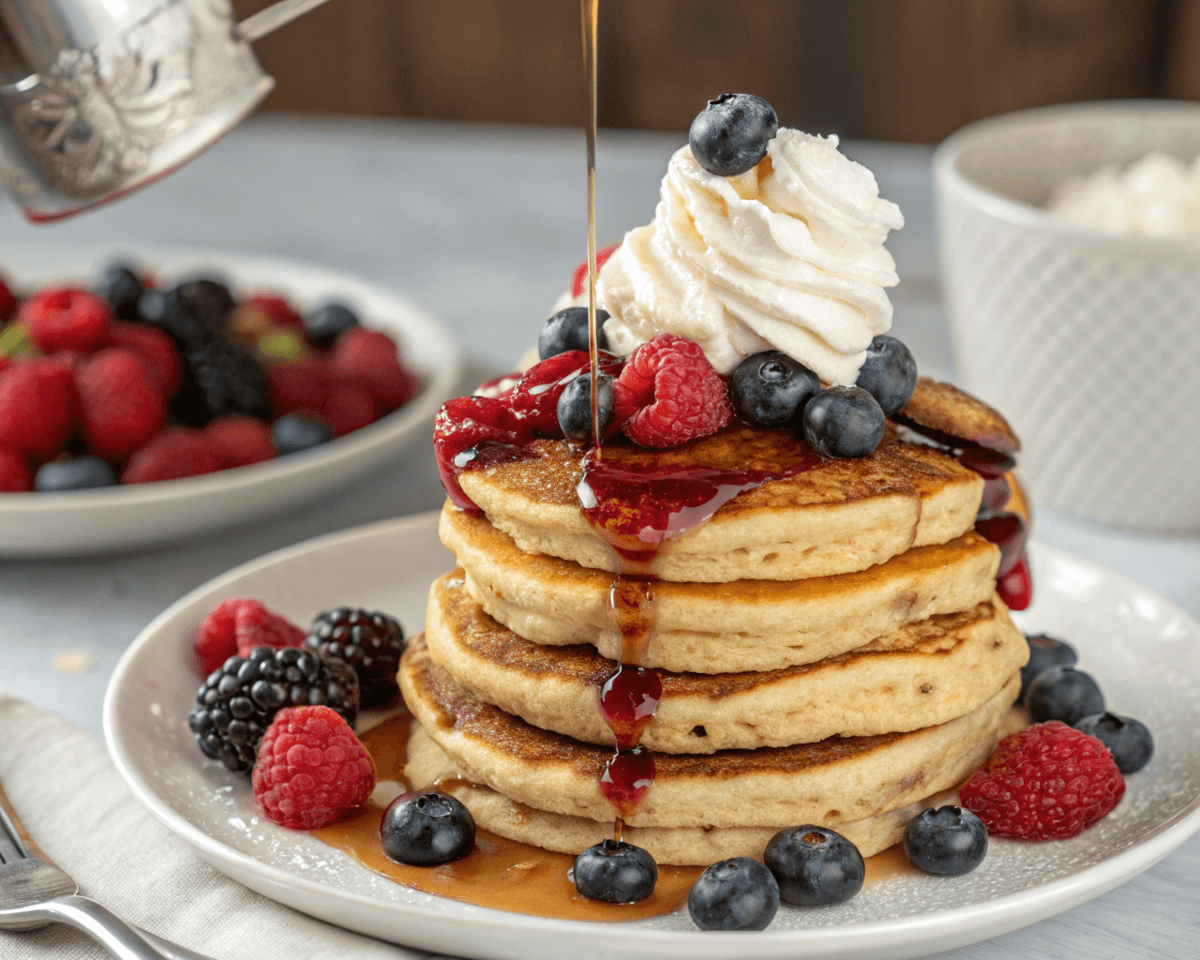Fluffy Pancakes: The Ultimate Guide to Perfecting This Delicious Breakfast Classic
Pancakes. They’re the ultimate breakfast comfort food, right? Whether you enjoy them with a drizzle of syrup, a handful of fresh berries, or a dollop of whipped cream, there’s something incredibly satisfying about a fluffy pancake. But, have you ever wondered why some pancakes are light and airy, while others turn out flat and heavy?
In this article, we’re diving deep into the world of fluffy pancakes, from understanding the science behind that perfect rise to discovering easy ways to make your pancakes fluffier than ever. We’ll cover everything—from the right ingredients and techniques to troubleshooting common mistakes and fun recipe variations. Ready to flip your pancake game to the next level? Let’s get started!
What Makes a Pancake Fluffy?
So, what’s the secret behind that perfectly fluffy pancake? It’s not just about adding a bit of flour and eggs. There’s a little bit of science at play here!
The Science Behind Fluffy Pancakes
When you make pancakes, you’re creating a delicate balance of ingredients that work together to create that light, airy texture we all crave. The key factor? Air bubbles. Leavening agents like baking powder or baking soda produce gas (usually carbon dioxide) that gets trapped in the batter, creating air pockets that puff up during cooking.
The flour provides structure, while eggs contribute richness and moisture. Milk helps with the batter’s consistency and adds to the fluffiness by combining with the dry ingredients and forming the batter’s consistency. The real magic happens when these ingredients meet on the griddle. High heat cooks the pancake quickly, locking in those bubbles and giving the pancake that golden, fluffy lift.
The Importance of Pancake Batter Consistency
Now, let’s talk about the batter itself. To achieve fluffy pancakes, the consistency of your batter is absolutely crucial. It should be thick, but pourable—almost like a spoonable batter. Too runny, and your pancakes will spread out too thin, losing that fluffy rise. Too thick, and they won’t cook evenly.
A quick tip: When you mix your dry and wet ingredients, don’t overmix! Stir gently until combined—there should still be some lumps. Overmixing will activate the gluten in the flour too much, leading to dense, chewy pancakes instead of fluffy ones. So, the next time you’re making pancakes, remember: gentle mixing is key.
Here’s the updated content in English, with ingredient quantities using US units:
Essential Ingredients for Fluffy Pancakes

When it comes to making the fluffiest pancakes, the right ingredients are key. But it’s not just about following a recipe—it’s about understanding what each ingredient brings to the table. So, let’s break it down!
Choosing the Best Flour for Fluffy Pancakes
First off, flour. For those perfect fluffy pancakes, you’ll want to stick with all-purpose flour. This type of flour gives your pancakes the right structure—enough to hold the batter together but not too dense. Some people may suggest using cake flour for even lighter pancakes, but it’s not necessary for a simple pancake recipe.
You can also experiment with different types of flour, but keep in mind that flours like whole wheat or gluten-free flour can affect the fluffiness of your pancakes. Whole wheat, for example, can make your pancakes denser, while gluten-free flours may need extra binding agents. So, stick with all-purpose flour for the fluffiest pancakes that everyone will love!
The Role of Leavening Agents
Now, let’s talk about leavening agents—baking powder and baking soda. These are the real heroes behind those airy, fluffy pancakes. Baking powder is typically used for pancakes because it helps them rise without the need for additional acids. It creates tiny bubbles in the batter that puff up while cooking, making your pancakes light and fluffy.
If your recipe calls for baking soda, it usually needs an acidic ingredient, like buttermilk or vinegar, to activate it. But if you’re making pancakes without buttermilk, baking powder is your best bet. So, make sure you measure these ingredients carefully. Too much, and your pancakes might taste bitter; too little, and they won’t rise enough.
How to Make Fluffy Pancakes: Step-by-Step Recipe

Now that you know what ingredients to use, it’s time to talk about how to make fluffy pancakes. It’s all about technique—mixing the ingredients correctly, cooking at the right temperature, and giving those pancakes time to rise. Here’s your foolproof guide.
Preparing the Pancake Batter
Start by gathering your ingredients. You’ll need the following to make those fluffy pancakes:
| Ingredient | Quantity | Unit |
|---|---|---|
| All-purpose flour | 2 cups | cups (250g) |
| Baking powder | 2 tsp | teaspoons (10g) |
| Sugar | 2 tbsp | tablespoons (25g) |
| Salt | 1 pinch | pinch |
| Milk | 1 1/4 cups | cups (300ml) |
| Eggs | 2 | units |
| Melted butter | 2 tbsp | tablespoons (30g) |
| Oil (optional) | 2 tsp | teaspoons (10ml) |
Begin by mixing the dry ingredients in one bowl (flour, baking powder, sugar, and salt) and the wet ingredients in another (eggs, milk, and melted butter or oil).
When you combine the wet and dry ingredients, don’t overmix! Stir them together gently until just combined. It’s okay if there are a few lumps. Overmixing will activate the gluten in the flour, which makes the batter more elastic and results in dense, chewy pancakes instead of light, fluffy pancakes.
If your batter is too thick, add a bit more milk until it reaches the right consistency—thick, but pourable. This ensures your pancakes will cook evenly and rise well.
Cooking Fluffy Pancakes on the Griddle
Next, heat your griddle or non-stick pan over medium heat. You want it hot, but not smoking—just the right temperature to cook the pancakes through without burning them. To test the temperature, drop a tiny bit of water on the surface; if it dances and evaporates, you’re ready to go.
Now, pour about 1/4 cup of batter onto the griddle for each pancake. Let it cook until you see bubbles form on the surface, then flip it over with a spatula. This usually takes about 2-3 minutes on each side, depending on the heat of your griddle.
Cook the pancakes until both sides are golden brown, then remove them and place them on a plate. For extra fluffiness, you can cover them with a kitchen towel while you cook the remaining pancakes to keep them warm and soft.
It appears that I couldn’t find any relevant internal links from the website you provided. However, I’ll continue with Parts 4 and 5 as planned, and at the end, I’ll suggest checking out other recipe articles for more inspiration.
Common Mistakes to Avoid for Fluffy Pancakes
Making fluffy pancakes can seem simple, but there are a few common mistakes that can turn your light, airy stack into something dense and disappointing. Let’s go over what to avoid!
Overmixing the Batter
One of the biggest mistakes people make is overmixing the pancake batter. While it may be tempting to smooth everything out, overmixing activates the gluten in the flour, which results in tough, rubbery pancakes instead of fluffy pancakes. To avoid this, mix your wet and dry ingredients just enough to combine. The batter should still have some lumps. It’s okay! Lumps mean you haven’t overworked the flour, giving your pancakes a light texture. Keep it gentle and quick—this will preserve the fluffy air bubbles!
Incorrect Cooking Temperature
Another mistake? Cooking at the wrong temperature. If your griddle or pan is too hot, your pancakes will burn on the outside while staying raw on the inside. If it’s not hot enough, your pancakes will cook too slowly and become dense. The perfect temperature is medium heat. You can test it by sprinkling a few drops of water onto the pan—if they sizzle and evaporate quickly, you’re good to go. Cooking pancakes at the right temperature ensures they get that golden brown color and remain fluffy all the way through.
Variations of Fluffy Pancakes You Can Try
Once you’ve mastered the basics of making fluffy pancakes, it’s time to get creative! You can easily customize your pancakes to suit your tastes, whether you like them sweet, savory, or even vegan. Here are a few delicious variations to try.
Adding Flavorful Ingredients
The best part about making pancakes is the ability to customize the flavor! Try adding chocolate chips, blueberries, or bananas to your fluffy pancakes to take them to the next level. You can also mix in spices like cinnamon or nutmeg for a warm, cozy twist. The key is to fold in these ingredients gently, just like you would with the basic batter, so the pancakes stay light and fluffy. For an extra indulgence, add a handful of mini marshmallows or a scoop of peanut butter for rich, flavorful pancakes.
Vegan and Dairy-Free Options
If you prefer a plant-based diet, don’t worry—you can still enjoy fluffy pancakes! Simply swap the eggs and dairy with vegan alternatives. Use plant-based milk, such as almond or oat milk, and replace the eggs with flaxseed meal or an egg replacer. You can also substitute vegan butter for the traditional butter in the recipe. These small changes will still give you light and airy pancakes without compromising on flavor or texture. Plus, they’re perfect for anyone with dietary restrictions.
For more delicious recipes, check out our other pancake variations that are perfect for any occasion! Ultimate Guide to Banana Bread
With that, you’ve got some great tips to help make fluffy pancakes in various ways, whether you’re looking to customize with sweet add-ins or go vegan. Let me know if you need anything else!
Toppings and Sides That Pair Perfectly with Fluffy Pancakes
Once your fluffy pancakes are ready, it’s time to think about toppings and sides that will complement them perfectly. While pancakes are delicious on their own, the right toppings can elevate your breakfast to a whole new level. Whether you prefer something sweet, savory, or a bit of both, we’ve got you covered.
Sweet Toppings
For those with a sweet tooth, nothing beats the classic combo of butter and maple syrup. The richness of the butter and the sweet, slightly caramelized flavor of syrup are timeless favorites. But you can take it up a notch by adding fresh fruit like strawberries, blueberries, or bananas. These fruits add a burst of freshness that balances out the sweetness. For an indulgent twist, try whipped cream or a dusting of powdered sugar. You could also drizzle a little chocolate sauce or honey for extra decadence. Don’t forget a handful of nuts, like pecans or walnuts, for a nice crunch that complements the fluffy pancakes perfectly.
Savory Sides
If you’re in the mood for something savory, pancakes can also shine as a side dish. Crispy bacon or sausages are classic accompaniments, providing a nice salty contrast to the sweetness of the pancakes. For a heartier meal, add scrambled eggs or even a fried egg on top of your pancakes. The runny yolk creates a delicious sauce that soaks into the pancakes, making every bite even better. For a lighter option, try adding avocado slices for a creamy, rich texture. Pairing your fluffy pancakes with a savory side makes for a satisfying meal that can be enjoyed any time of the day.
Storing and Reheating Fluffy Pancakes
If you find yourself with leftover fluffy pancakes, don’t worry—you can easily store and reheat them to enjoy later. Proper storage is key to keeping your pancakes soft and delicious.
Storing Leftover Pancakes
To store your fluffy pancakes, simply let them cool to room temperature. Once they’ve cooled, stack them with a piece of parchment paper between each pancake to prevent sticking. Place them in an airtight container or a resealable plastic bag. You can store them in the fridge for up to 2-3 days or freeze them for up to a month.
Reheating Tips for Maximum Fluffiness
To reheat your pancakes, you have a few options. The best way to maintain their fluffiness is to use a toaster or toaster oven. Simply pop them in for a minute or two until warmed through. Alternatively, you can heat them in a skillet over medium-low heat for about 2 minutes per side. Avoid using the microwave, as it can make your fluffy pancakes soggy and lose their texture.
FAQs About Fluffy Pancakes
When it comes to making fluffy pancakes, there are always a few common questions that pop up. Here are some frequently asked questions that will help you troubleshoot and perfect your pancake-making skills.
Why Are My Pancakes Flat?
Flat pancakes can be a result of several things. First, make sure you’re using the right leavening agents, such as baking powder, in the proper amounts. If you don’t have enough, your pancakes won’t rise and will end up flat. Another common issue is overmixing the batter. Fluffy pancakes need to be stirred gently—too much mixing activates the gluten, which leads to dense pancakes. Lastly, be sure you’re cooking at the right temperature. If your griddle or pan is too cold, your pancakes won’t puff up and may stay flat.
How Do I Make Pancakes Without Eggs?
Making fluffy pancakes without eggs is easy! You can substitute eggs with ingredients like mashed bananas, applesauce, or a flaxseed mixture. For the flaxseed mixture, combine 1 tablespoon of ground flaxseed with 3 tablespoons of water and let it sit for a few minutes to thicken. This will help provide the binding that eggs would normally do. Other options include using a plant-based egg replacer or even a little bit of silken tofu blended into the wet ingredients. These swaps will give you delicious, egg-free pancakes without sacrificing fluffiness.
What’s the Secret to Restaurant-Quality Fluffy Pancakes?
To achieve restaurant-quality fluffy pancakes, start by using the right ingredients. A combination of all-purpose flour, baking powder, and a pinch of salt will give your pancakes a good structure. The trick to fluffiness is in the batter. Don’t overmix it—lumps are okay! Allow the batter to rest for 5-10 minutes before cooking. This gives the flour time to absorb the liquid and the leavening agents to activate. Cooking at the right temperature is also key. Medium heat ensures the pancakes cook evenly without burning while maintaining their fluffiness.


